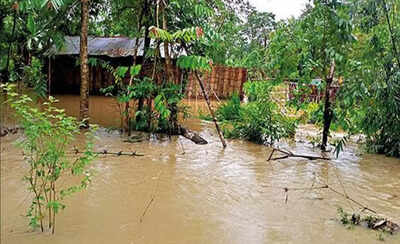- News
- City News
- guwahati News
- 'Assam among 5 states vulnerable to extreme climate events'
'Assam among 5 states vulnerable to extreme climate events'
'Assam among 5 states vulnerable to extreme climate events'

The northeastern zone, including Assam, Manipur, Sikkim, and Arunachal Pradesh, is highly exposed to extreme flood events
GUWAHATI: Assam, which has witnessed rainfall deficit of over 20% for the sixth time since 2010, is among the five states that are highly vulnerable to extreme climate events such as floods, droughts and cyclones, according to a new study by the Council on Energy, Environment and Water (CEEW).
The study, "Mapping India's Climate Vulnerability - A District-Level Assessment" done by Delhi-based think-tank CEEW, has faulted unsustainable landscape, lack of infrastructure planning and human-induced microclimate change as the key drivers of this high vulnerability.
It has analysed 640 districts of the country, of which 463 are vulnerable to extreme floods, droughts and cyclones. Assam's Dhemaji and Nagaon are the most vulnerable districts of India, finds the study. It has said although the northeastern zone has a medium adaptive capacity, states like Assam, Arunachal Pradesh and Manipur have low adaptive capacities and are highly vulnerable to extreme floods.
"The northeastern zone bears the brunt of the south west monsoon, which is responsible for the heavy precipitation that drives flood events. The northern and northeastern zones are more vulnerable to extreme flood events and their compounding impacts," it said.
The northeastern zone, including Assam, Manipur, Sikkim, and Arunachal Pradesh, is only highly exposed to extreme flood events. Kamrup, Lakhimpur, Karbi Anglong, Hailakandi, Tinsukia and Dhemaji districts are also the flood hotspots in India, the study says.
"The frequency and intensity of extreme climate events in India have increased by almost 200% since 2005. Our policymakers, industry leaders and citizens must use the district-level analysis to make effective risk-informed decisions," says CEEW programme lead and author of the study, Abinash Mohanty.
He adds, "Climate-proofing of physical and ecosystem infrastructures should also now become a national imperative. Further, India must create a new Climate Risk Commission to coordinate the environmental de-risking mission. Finally, with loss and damage rising exponentially due to the climate crisis, India must demand climate finance for adaptation-based climate actions at CO."
"A surge in extreme events has been observed across India after 2005. Our sensitivity analysis shows that this is primarily triggered by landscape disruptions. Various studies have confirmed the impact of landscape changes on the incidence of extreme events (UNEP 2009)," the study said.
The study, "Mapping India's Climate Vulnerability - A District-Level Assessment" done by Delhi-based think-tank CEEW, has faulted unsustainable landscape, lack of infrastructure planning and human-induced microclimate change as the key drivers of this high vulnerability.
It has analysed 640 districts of the country, of which 463 are vulnerable to extreme floods, droughts and cyclones. Assam's Dhemaji and Nagaon are the most vulnerable districts of India, finds the study. It has said although the northeastern zone has a medium adaptive capacity, states like Assam, Arunachal Pradesh and Manipur have low adaptive capacities and are highly vulnerable to extreme floods.
"The northeastern zone bears the brunt of the south west monsoon, which is responsible for the heavy precipitation that drives flood events. The northern and northeastern zones are more vulnerable to extreme flood events and their compounding impacts," it said.
The northeastern zone, including Assam, Manipur, Sikkim, and Arunachal Pradesh, is only highly exposed to extreme flood events. Kamrup, Lakhimpur, Karbi Anglong, Hailakandi, Tinsukia and Dhemaji districts are also the flood hotspots in India, the study says.
"The frequency and intensity of extreme climate events in India have increased by almost 200% since 2005. Our policymakers, industry leaders and citizens must use the district-level analysis to make effective risk-informed decisions," says CEEW programme lead and author of the study, Abinash Mohanty.
He adds, "Climate-proofing of physical and ecosystem infrastructures should also now become a national imperative. Further, India must create a new Climate Risk Commission to coordinate the environmental de-risking mission. Finally, with loss and damage rising exponentially due to the climate crisis, India must demand climate finance for adaptation-based climate actions at CO."
"A surge in extreme events has been observed across India after 2005. Our sensitivity analysis shows that this is primarily triggered by landscape disruptions. Various studies have confirmed the impact of landscape changes on the incidence of extreme events (UNEP 2009)," the study said.
FacebookTwitterLinkedinEMail
Start a Conversation
end of article
Quick Links
Delhi Air PollutionDelhi TemperatureChennai WeatherBangalore TemperatureCovid vaccination centres in DelhiCoronavirus in DelhiRTPCR test in GurgaonHyderabad RainPollution level in BangaloreDelhi SmogDelhi TemperatureNoida AQIGurgaon AQI todayFire in MumbaiMumbai RainsCovid 19 RT PCR Test in NoidaDelhi AQI todaySrinagar encounter

